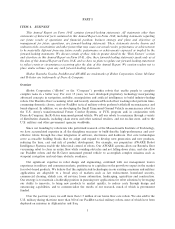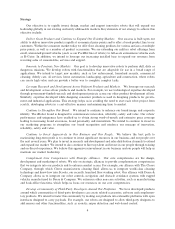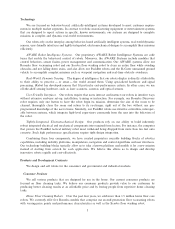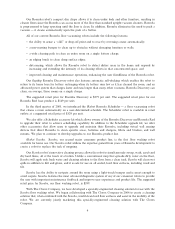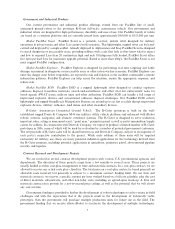iRobot 2005 Annual Report Download - page 17
Download and view the complete annual report
Please find page 17 of the 2005 iRobot annual report below. You can navigate through the pages in the report by either clicking on the pages listed below, or by using the keyword search tool below to find specific information within the annual report.including detailed regression testing. The product is then turned over to the contract manufacturer for volume
production.
Spiral Development
One of the methods we use to develop military products is a ""spiral development'' process to get field
tested equipment to the troops quickly. After we develop a new product or product upgrade that will fill the
desired capability of the user, it is tested with soldiers in the field. The user provides performance feedback on
the product to the in-field engineer. Revisions are made quickly to retest in the field. This method has allowed
our research and development team to not only make revisions on existing products quickly and efficiently, but
also to capture feedback for future upgrades and innovations to meet user needs. An example of our spiral
development process was the introduction of our first PackBot tactical military robot. When the PackBot was
first deployed by the U.S. Army in Afghanistan, we sent one of our technical program managers into the field
with the robot. The soldiers gave feedback upon returning from a mission, and our development team made
the desired changes to the software. These changes were then downloaded to the PackBot in Afghanistan,
sometimes even before the next mission. In addition, based on design ideas from the soldiers using the
PackBot, our engineers developed the PackBot Explorer, a recent addition to our PackBot product line. We
intend to solicit similar user feedback in the field for the new prototype R-Gator intelligent vehicle to capture
the users' operational requirements as the product advances in development.
Leveraged Model
Our research and development efforts for our next-generation products are supported by a variety of
sources. Our research and development efforts for our next-generation military products are predominately
supported by U.S. governmental research organizations such as the Defense Advanced Research Projects
Agency, or DARPA, U.S. Space and Warfare Command, or SPAWAR, Technical Support Working Group,
or TSWG, and the U.S. Army's FCS program. While the U.S. government retains certain rights in the
research projects that it has funded, we retain ownership of patents and know-how and are generally free to
develop other commercial products, including consumer and industrial products, utilizing the technologies
developed during these projects. Similarly, expertise developed while designing consumer products is used in
designing products for government and industrial applications. We also work with strategic collaborators to
develop industry-specific technologies. Moreover, we continue to reinvest in advanced research and develop-
ment projects to maintain our technical capability and to enhance our product offerings.
Competition
The market for robots is highly competitive, rapidly evolving and subject to changing technologies,
shifting customer needs and expectations and the likely increased introduction of new products. We believe
that a number of established companies have developed or are developing robots that will compete directly
with our product offerings, and many of our competitors have significantly more financial and other resources
than we possess. Our current principal competitors include:
‚ developers of robotic floor care products such as AB Electrolux, Alfred Karcher GmbH & Co.,
Samsung Electronics Co., Ltd., LG Electronics Inc., Infinuvo/Metapo, Inc, Matsutek Enterprises Co
Ltd. and Yujin Robotic Co. Ltd.;
‚ developers of small unmanned ground vehicles such as Foster-Miller, Inc. Ì a wholly owned
subsidiary of QinetiQ North America, Inc., Allen-Vanguard Corporation, and Remotec Ì a division of
Northrop Grumman Corporation; and
‚ established government contractors working on unmanned systems such as Lockheed Martin Corpora-
tion, BAE Systems, Inc. and General Dynamics Corporation.
While we believe many of our customers purchase our Roomba floor cleaning robots as a supplement to,
rather than a replacement for, their traditional vacuum cleaners, we do compete in some cases with providers
of traditional vacuum cleaners.
13


